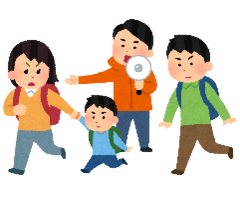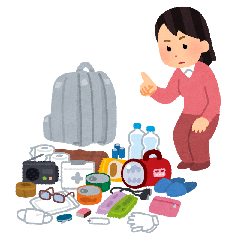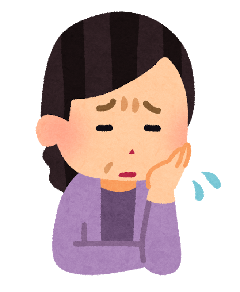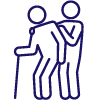- Yokohama-shi Top Page
- Izumi Ward Top Page
- Disaster Prevention and anti-crime program
- Disaster Prevention and Disasters
- Wind and flood damage Q & A (Frequently Asked Questions)
Here's the text.
Wind and flood damage Q & A (Frequently Asked Questions)
Get knowledge of storm and flood damage and prepare for storm and flood damage.
Last Updated December 11, 2023
Contents
About evacuation
- When should I evacuate?
- Where is evacuation sites?
- How do I get evacuation information?
- What do you have when you evacuate?
- What are your clothes when you evacuate?
- Can I take my pet to evacuation sites?
- Although it is not a target area for evacuation information, I want to evacuate because I am worried.
About hazard map
If damage occurs
- Confirmation and reporting of damage
- In the event of a power outage
- About certificate of damage / disaster's Book
- Relief and support systems implemented by ward offices
About evacuation
When should I evacuate?

When evacuation information is issued in the area where you live, start evacuation action immediately. If you live in an area where there is no danger of flooding or landslides, please ensure safety at home. .
There are two types of evacuation behavior: horizontal evacuation, which moves to evacuation sites and acquaintances' homes, and vertical evacuation, which moves to the second floor, which is beyond flooding. Take appropriate evacuation actions according to the disaster risk at home.
It is also important to check the situation outside at the time when you decide to evacuate. When evacuating horizontally, it is important to stop horizontal evacuation and switch to vertical evacuation at home, etc. in situations where it is difficult to walk due to road flooding or when there is a danger such as flying objects due to strong winds.
Oh Those who take time to evacuate, such as the elderly and the disabled.
[Alert Level 3] Evacuation actions start with evacuation preparations and evacuation of elderly people, etc.
Oh Others
[Alert Level 3] Evacuation preparation ・ Preparation for evacuation by starting evacuation of elderly people etc.
[Alert Level 4] Start evacuation at evacuation warning or evacuation warning (emergency)
Where is evacuation sites?

Elementary and junior high schools near the area where evacuation information was issued (in some cases, district centers) will be established as evacuation sites.
Not all elementary and junior high schools will be opened as evacuation sites, so please check the status of evacuation sites before evacuating.
evacuation sites, which is open, can be confirmed by the following means.
・ Izumi Ward homepage
・ Traveling public relations by public relations vehicles (only in areas subject to evacuation information)
・ Izumi Ward Twitter
・ News of TV, etc.
How do I get evacuation information?

When evacuation information is issued, a public relations car of the ward office will patrol the target area and inform you.
You can also get information on the Izumi Ward website, Twitter, TV and radio.
If you have a mobile phone, you can receive e-mails such as evacuation information, river water level information, etc. by registering for "Yokohama City Disaster Prevention Information E-mail".
What do you have when you evacuate?

There is no provision of food or supplies in evacuation sites during storms and floods.
When evacuating, bring a minimum of food (which can be eaten as it is), drinking water, changing clothes, everyday medicine, license, insurance card, and valuables. Also, bring a mask as a countermeasure against infectious diseases.
[Another useful thing]
・Chargers such as towels, indoor shoes, mobile phones, etc. (can be charged without an outlet)
・Compact mat for tissues, wet tissues, plastic bags, and camping (used when lie down)
・Recreational goods such as books, ear plugs (those who can't sleep due to the surrounding sounds), eye masks
What are the clothes and precautions for evacuation?
When evacuating, prepare clothes and belongings with the following points in mind.
Oh Whether both hands are free
Do not use anything that cannot be used without hand, such as flashlights, bags, umbrellas, etc.
In addition to storms and floods, it is important to "empt both hands" for evacuation in the event of a disaster.
・ Flashlight → Headlight
・ Bags → Rucksack
・ Umbrella → Raincoat
Oh Don't get wet
Put a plastic bag in a rucksack, put your belongings in it, and tie your mouth.
In addition, wearing a large plastic bag from the outside of the rucksack makes it difficult for luggage to get wet.
Oh The shoes are athletic shoes (sneakers)
Evacuation with boots may not be possible if water enters the boots.
Also, evacuation with sandals that expose the skin can cause injury.
Be sure to wear athletic shoes (sneakers) when evacuating.
Oh Beware of steps and obstacles on flooded roads
If flooding occurs on the evacuation route, care must be taken not to cause injury.
It is also effective to check with something like a cane, as steps and obstacles may be invisible, or the manhole cover may be removed due to backflow of sewage.
If you have to go through a flooded route, consider switching to vertical evacuation at home.
Can I take my pet to evacuation sites?

If evacuation is required in an area where dangers such as flooding are expected, evacuate your pet together. However, be sure to put them in pet cages when evacuating, and the owner is responsible for taking care of them in evacuation sites.
Pets can be stressful in unfamiliar environments, so if you don't need to evacuate outside the inundation area, stay at home.
It is also effective to secure in advance an environment where you can spend more comfortably than evacuation sites, such as acquaintances' homes and pet hotels.
Although it is not a target area for evacuation information, I want to evacuate because I am worried.

If you have opened evacuation sites, you can use the evacuation sites that is currently open. However, from the viewpoint of preventing the spread of infectious diseases, be sure to ensure safety at home if there is no assumption of flooding.
In order to stay at home more safely, close the shutters and shutters, and prepare LED lanterns in case of a power outage. Windows without shutters can be taken with glass shatterproof film or tape to reduce damage in the event that glass breaks.
If you experience any danger while waiting at home, move to a safe place, such as indoors, and call 119 or contact the ward office General Affairs Division (☎045-800-2309).
About hazard map
What is a hazard map?
Hazard maps are maps that show the locations of disaster-prevention areas and disaster-related facilities such as evacuation sites for the purpose of reducing damage caused by natural disasters and for disaster prevention measures.
We have created three types of flood, inland water, and landslide disasters so that we can accurately grasp the disaster risks in the region and take appropriate actions in case of emergency.
Where can I see the hazard map?
Hazard maps are distributed free of charge at Izumi Ward Office General Affairs Division (305th floor on the third floor).
You can also check various maps from the "Disaster Prevention Map" page on the Izumi Ward website.
If damage occurs
Confirmation and reporting of damage
Be sure to check the damage after the rain and wind are weakened and brightened.
(Even if it is checked in the dark rain and wind, it is rarely possible to respond at that time.)
If the damage is confirmed, please inform the Izumi Ward Office General Affairs Division (☎045-800-2309) of the damage situation.
However, if a landslide occurs or if you notice any damage that affects human life, please notify us immediately when you notice it.
Damage related to human life
☎ Please report to 119
Land and sand disaster
☎ 045-800-2309 (Izumi Ward Office, General Affairs Division)
In the event of a power outage
The ward office cannot provide details on the status of power outages and the expected recovery.
Please check the website of Tokyo Electric Power Grid Co., Ltd. (outside site).
About certificate of damage / disaster's Book
What is certificate of damage / disaster?
The certificate of damage / disaster Book is a document certifying the damage caused by the disaster and is issued by the ward office based on an application from the survivors.
If you receive compensation from various relief and support systems or individual insurance companies, you may need a certificate of damage / disastercertificate of damage / disaster book issued by the ward office. If you need, please apply to the ward office.
Publishing the certificate of damage / disaster Book
In order to issue a certificate of damage / disaster book, it is necessary for the ward staff to check the site in advance, so be sure to contact Izumi Ward General Affairs Division in case of damage.
※certificate of damage / disaster cannot be issued for personal property. In the case of movable property, we will issue a “ri disaster notification certificate” instead of proving the fact that the person has reported the damage to the government.
※If a certain period of time has passed since the disaster and the causal relationship between the disaster and the damaged property cannot be confirmed, the certificate of damage / disaster Book cannot be issued. In that case, we will issue a "Ri disaster notification certificate" instead.
survivors Support System
Please check the support page of survivors.
Inquiries to this page
Izumi Ward Office General Affairs Division Disaster Prevention Officer
Telephone: 045-800-2309
Telephone: 045-800-2309
Fax: 045-800-2505
Email address: iz-bousai@city.yokohama.jp
Page ID: 848-171-884













